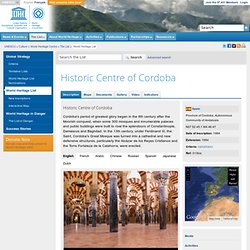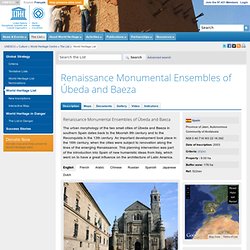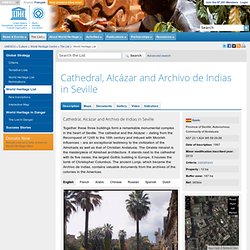

Islas Baleares. Asturias. Galicia. Cantabria. País Vasco. Valencia. La Rioja. Cataluña. Aragón. Costa Mediterránea. Cast-León. Madrid. Extremadura. Cast- Mancha. Andalucía. 5. Almería, Granada, Jaén, Huelva. Rock Art of the Mediterranean Basin on the Iberian Peninsula. Rock Art of the Mediterranean Basin on the Iberian Peninsula The late prehistoric rock-art sites of the Mediterranean seaboard of the Iberian peninsula form an exceptionally large group.

Here the way of life during a critical phase of human development is vividly and graphically depicted in paintings whose style and subject matter are unique. Art rupestre du bassin méditerranéen de la péninsule Ibérique Ces sites d'art rupestre de la fin de la préhistoire, sur les bords méditerranéens de la péninsule Ibérique, constituent un ensemble d'une taille exceptionnelle qui décrit le mode de vie, à une phase critique du développement humain, de manière vivante et graphique dans des peintures uniques par leur style et leur sujet. فنّ صخري في حوض البحر الأبيض المتوسط لشبه الجزيرة الإسبانيّة source: UNESCO/ERI 伊比利亚半岛地中海盆地的石壁画艺术 伊比利亚半岛地中海盆地的史前晚期石壁画艺术遗址形成了一个独特的大规模壁画群。 Наскальная живопись в средиземноморской части Пиренейского полуострова Arte rupestre del arco mediterráneo de la Península Ibérica.
Historic Centre of Cordoba. Historic Centre of Cordoba Cordoba's period of greatest glory began in the 8th century after the Moorish conquest, when some 300 mosques and innumerable palaces and public buildings were built to rival the splendours of Constantinople, Damascus and Baghdad.

In the 13th century, under Ferdinand III, the Saint, Cordoba's Great Mosque was turned into a cathedral and new defensive structures, particularly the Alcázar de los Reyes Cristianos and the Torre Fortaleza de la Calahorra, were erected. Centre historique de Cordoue La période glorieuse de Cordoue a commencé au VIIIe siècle quand elle a été conquise par les Maures et qu'ont été construits quelque 300 mosquées et d'innombrables palais et édifices publics, rivalisant avec les splendeurs de Constantinople, Damas et Bagdad.
وسط قرطبة التاريخي بدأ نجم قرطبة يسطع في القرن الثامن عندما دخلها العرب الذي شيّدوا فيها حوالى 300 جامع والعديد من القصور والمباني العامة مزاحمين روائع القسطنطينيّة ودمشق وبغداد. Source: UNESCO/ERI 科尔多瓦历史中心. Alhambra, Generalife and Albayzín, Granada. Renaissance Monumental Ensembles of Úbeda and Baeza. Renaissance Monumental Ensembles of Úbeda and Baeza The urban morphology of the two small cities of Úbeda and Baeza in southern Spain dates back to the Moorish 9th century and to the Reconquista in the 13th century.

An important development took place in the 16th century, when the cities were subject to renovation along the lines of the emerging Renaissance. This planning intervention was part of the introduction into Spain of new humanistic ideas from Italy, which went on to have a great influence on the architecture of Latin America. Ensembles monumentaux Renaissance de Úbeda et Baeza Les deux petites villes d’Úbeda et Baeza, dans le sud de l’Espagne, ont été dotées de leur forme urbaine à la période mauresque, au IXe siècle, et après la Reconquista au XIIIe siècle.
مجمّعات فنيّة نهضويّة في أوبيدا وبايزا نالت مدينتا أوبيدا وبايزا الوقعتان جنوب اسبانيا شكلهما الحضري في الحقبة المغربيّة في القرن التاسع وبعد الفتح في القرن الثالث عشر. Cathedral, Alcázar and Archivo de Indias in Seville. Outstanding Universal Value Brief synthesis Together the Cathedral, Alcázar and Archivo de Indias as a series, form a remarkable monumental complex in the heart of Seville.

They perfectly epitomize the Spanish "Golden Age", incorporating vestiges of Islamic culture, centuries of ecclesiastical power, royal sovereignty and the trading power that Spain acquired through its colonies in the New World. Founded in 1403 on the site of a former mosque, the Cathedral, built in Gothic and Renaissance style, covers seven centuries of history. With its five naves it is the largest Gothic building in Europe. The original nucleus of the Alcázar was constructed in the 10th century as the palace of the Moslem governor, and is used even today as the Spanish royal family's residence in this city, thereby retaining the same purpose for which it was originally intended: as a residence of monarchs and heads of state.
Each one of these monuments is associated with the colonization process. Doñana National Park. Doñana National Park Doñana National Park in Andalusia occupies the right bank of the Guadalquivir river at its estuary on the Atlantic Ocean.

It is notable for the great diversity of its biotopes, especially lagoons, marshlands, fixed and mobile dunes, scrub woodland and maquis. It is home to five threatened bird species. It is one of the largest heronries in the Mediterranean region and is the wintering site for more than 500,000 water fowl each year. Parc national de Doñana Situé en Andalousie, le parc de Doñana occupe la rive droite du Guadalquivir, à son estuaire sur l'océan Atlantique. منتزه دنيانا الوطني يقع المنتزه في الأندلس عند الضفّة اليمنى لنهر "غوادالكبير" (الوادي الكبير) في مصبّه على المحيط الأطلسي. Source: UNESCO/ERI 多南那国家公园 安达卢西亚的多南那国家公园位于瓜达尔基维尔河汇入大西洋入海口的右岸。 Национальный парк Доньяна Национальный парк Доньяна в Андалусии занимает правобережье эстуария реки Гвадалквивир вблизи ее впадения в Атлантический океан.